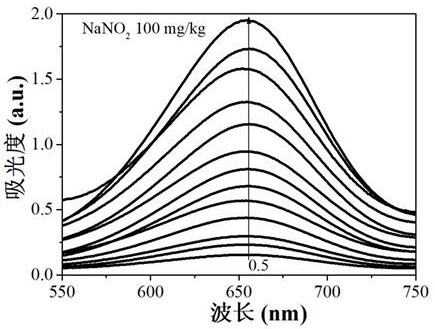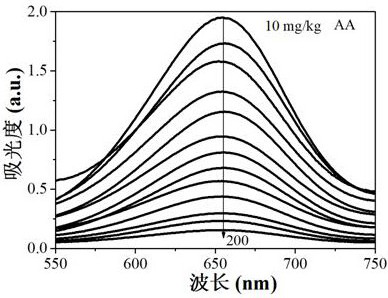Method for simultaneously detecting nitrite and ascorbic acid in food
A technology of nitrite and ascorbic acid, which is applied in the field of chemical analysis and detection, can solve the problems of direct application limitation and low enzyme activity, and achieve the effects of improving detection sensitivity and reproducibility, simple operation and strong selectivity
- Summary
- Abstract
- Description
- Claims
- Application Information
AI Technical Summary
Problems solved by technology
Method used
Image
Examples
Embodiment 1
[0029] Embodiment 1: the mensuration of nitrite and ascorbic acid in the pickle sample
[0030]1. Preparation of octanoic acid-coated ferric oxide nanomaterials: under nitrogen protection, 4.10 g of FeCl 3 ·6H 2 O and 2.82g (NH 4 ) 2 Fe(SO 4 ) 2 ·6H 2 O was dissolved in 50 mL of deionized water, stirred and heated to 80±5°C, and then 10 mL of concentrated NH was added dropwise to the solution 3 ·H 2 O, then add 2mL of octanoic acid to the solution, continue to stir the solution at 80±5°C for 40min, separate the magnetic material with a magnet, wash the separated magnetic material with ethanol and water three times in sequence, and coat 0.2g of octanoic acid with four Ferric oxide nanomaterials were dispersed in 80mL deionized water to obtain caprylic acid-coated ferric oxide;
[0031] 2. Preparation of modified activated carbon: soak 100g activated carbon in 0.1mol / L HCl solution for 2h, shake at room temperature for 15h, filter, then soak in 0.1mol / L potassium permang...
Embodiment 2
[0047] Embodiment 2: the mensuration of nitrite and ascorbic acid content in the green vegetables sample
[0048] 1. Preparation of octanoic acid-coated ferric oxide nanomaterials
[0049] Under nitrogen protection, the FeCl 3 ·6H 2 O and (NH 4 ) 2 Fe(SO 4 ) 2 ·6H 2 O was dissolved in deionized water, and after the solution was stirred and heated to 80±5°C, concentrated NH was added dropwise to the solution 3 ·H 2 O, then add octanoic acid to the solution, continue to stir the solution at 80±5°C for 50 min, separate the magnetic material with a magnet, and wash the separated magnetic material twice with ethanol and water respectively to obtain caprylic acid-coated ferric oxide ; where FeCl 3 ·6H 2 O:(NH 4 ) 2 Fe(SO 4 ) 2 ·6H 2 O: deionized water: concentrated NH 3 ·H 2 O: octanoic acid g:g:mL:mL:mL is 2:1:20:4:1;
[0050] 2. Preparation of modified activated carbon
[0051] Take activated carbon at 0.1mol / L HNO 3 After soaking in the solution for 2 hours, s...
Embodiment 3
[0062] Embodiment 3: the mensuration of nitrite and ascorbic acid content in the banana sample
[0063] 1. Preparation of octanoic acid-coated ferric oxide nanomaterials
[0064] Under nitrogen protection, the FeCl 3 ·6H 2 O and (NH 4 ) 2 Fe(SO 4 ) 2 ·6H 2 O was dissolved in deionized water, and after the solution was stirred and heated to 80±5°C, concentrated NH was added dropwise to the solution 3 ·H 2 O, then add octanoic acid to the solution, continue to stir the solution at 80±5°C for 40 min, separate the magnetic material with a magnet, and wash the separated magnetic material with ethanol and water three times respectively to obtain caprylic acid-coated trioxide Iron; where FeCl 3·6H 2 O:(NH 4 ) 2 Fe(SO 4 ) 2 ·6H 2 O: deionized water: concentrated NH 3 ·H 2 O: octanoic acid g:g:mL:mL:mL is 1.8:1:18:5:0.8;
[0065] 2. Preparation of modified activated carbon: same as Example 1;
[0066] 3, nitrite working curve making: with embodiment 1;
[0067] 4, a...
PUM
 Login to View More
Login to View More Abstract
Description
Claims
Application Information
 Login to View More
Login to View More - R&D
- Intellectual Property
- Life Sciences
- Materials
- Tech Scout
- Unparalleled Data Quality
- Higher Quality Content
- 60% Fewer Hallucinations
Browse by: Latest US Patents, China's latest patents, Technical Efficacy Thesaurus, Application Domain, Technology Topic, Popular Technical Reports.
© 2025 PatSnap. All rights reserved.Legal|Privacy policy|Modern Slavery Act Transparency Statement|Sitemap|About US| Contact US: help@patsnap.com



